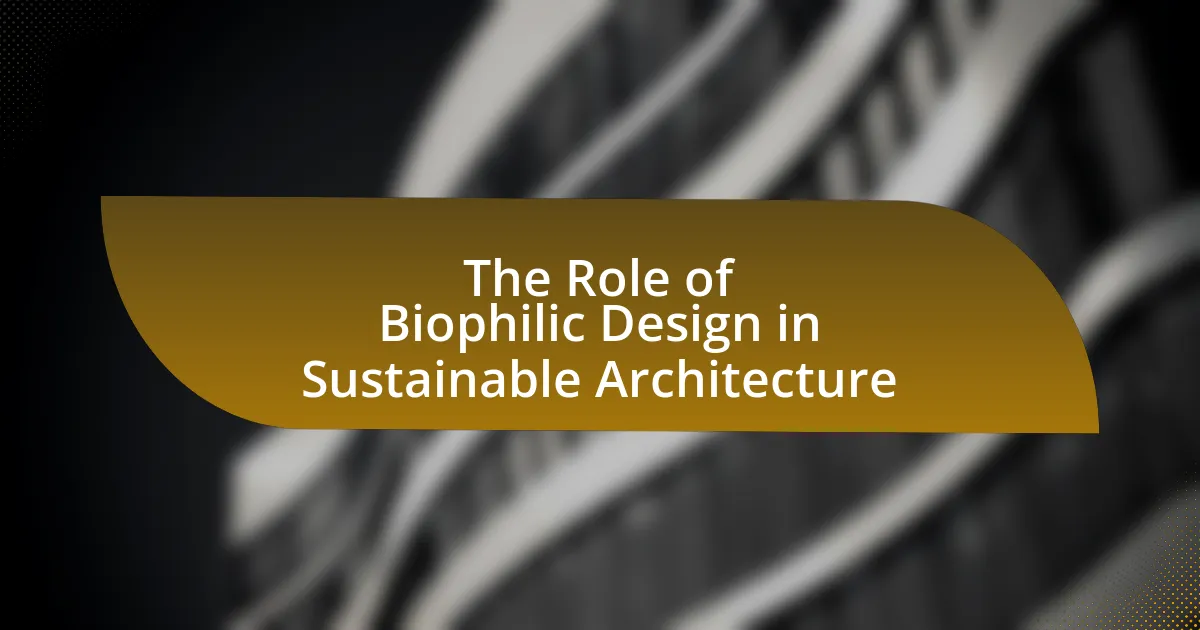Biophilic design in sustainable architecture is a design philosophy that integrates natural elements into building environments to enhance the connection between occupants and nature. This approach aims to improve well-being, productivity, and environmental sustainability by incorporating features such as natural light, vegetation, and water elements. The article explores how biophilic design contributes to sustainability, its key principles, and its impact on human well-being, productivity, and community engagement. Additionally, it addresses the challenges faced in traditional architecture, the historical roots and evolution of biophilic design, and the future trends and innovations shaping sustainable architecture.

What is Biophilic Design in Sustainable Architecture?
Biophilic design in sustainable architecture is an approach that integrates natural elements into building design to enhance the connection between occupants and nature. This design philosophy aims to improve well-being, productivity, and environmental sustainability by incorporating features such as natural light, vegetation, and water elements. Research indicates that biophilic design can reduce stress and increase creativity, as evidenced by a study published in the Journal of Environmental Psychology, which found that exposure to natural elements can significantly enhance mood and cognitive function.
How does Biophilic Design contribute to sustainability?
Biophilic design contributes to sustainability by integrating natural elements into built environments, which enhances ecological balance and promotes resource efficiency. This design approach encourages the use of sustainable materials, reduces energy consumption through natural ventilation and daylighting, and fosters biodiversity by incorporating green spaces. Research indicates that buildings designed with biophilic principles can reduce energy use by up to 30% and improve occupant well-being, leading to lower healthcare costs and increased productivity. By creating environments that connect people with nature, biophilic design not only supports individual health but also contributes to the overall sustainability of urban ecosystems.
What are the key principles of Biophilic Design?
The key principles of Biophilic Design include the integration of natural elements, the use of natural light, and the incorporation of organic forms and materials. These principles aim to create environments that enhance human well-being by fostering a connection to nature. For instance, studies have shown that spaces designed with natural light can improve mood and productivity, while the presence of plants can reduce stress levels. Additionally, incorporating organic shapes and textures can evoke a sense of comfort and familiarity, further promoting psychological benefits.
How does Biophilic Design enhance human well-being?
Biophilic Design enhances human well-being by integrating natural elements into built environments, which positively impacts mental and physical health. Research indicates that exposure to nature can reduce stress, improve mood, and enhance cognitive function. For instance, a study published in the Journal of Environmental Psychology found that individuals in environments with natural light and greenery reported lower levels of stress and higher levels of satisfaction. Additionally, biophilic design promotes social interaction and community engagement, further contributing to overall well-being.
Why is Biophilic Design important in modern architecture?
Biophilic design is important in modern architecture because it enhances human well-being by integrating natural elements into built environments. This design approach has been shown to reduce stress, improve cognitive function, and increase overall satisfaction among occupants. Research conducted by the University of Exeter found that workplaces incorporating biophilic elements can lead to a 15% increase in productivity. Furthermore, biophilic design promotes sustainability by encouraging the use of natural materials and energy-efficient systems, aligning with the goals of sustainable architecture.
What challenges does traditional architecture face?
Traditional architecture faces challenges such as the need for modernization, sustainability concerns, and the integration of technology. Modernization pressures arise as traditional designs often do not meet contemporary functional requirements, leading to a disconnect between historical aesthetics and current usability. Sustainability concerns are significant, as traditional materials and construction methods may not align with eco-friendly practices, contributing to environmental degradation. Additionally, the integration of technology poses a challenge, as traditional architecture may struggle to incorporate modern amenities without compromising its historical integrity. These challenges highlight the necessity for a balance between preserving cultural heritage and adapting to modern demands.
How does Biophilic Design address these challenges?
Biophilic Design addresses challenges in sustainable architecture by integrating natural elements into built environments, which enhances occupant well-being and reduces environmental impact. This design approach promotes the use of natural light, vegetation, and organic materials, which can improve air quality and reduce energy consumption. For instance, studies have shown that incorporating plants in indoor spaces can lower stress levels and increase productivity, as evidenced by research from the University of Queensland, which found a 37% reduction in stress levels among employees in biophilic office environments. Additionally, biophilic design can mitigate urban heat effects and promote biodiversity, contributing to more resilient ecosystems.
What are the historical roots of Biophilic Design?
Biophilic Design has its historical roots in the early 20th century, particularly influenced by the work of architect Frank Lloyd Wright, who emphasized harmony between nature and architecture. This concept gained further traction in the 1960s with the emergence of environmental psychology, which explored the psychological benefits of nature on human well-being. The term “biophilia,” coined by psychologist Erich Fromm in 1973, refers to the innate human affinity for nature, reinforcing the importance of integrating natural elements into built environments. Research by Edward O. Wilson in the 1980s further popularized biophilia, suggesting that humans have an evolutionary connection to nature, which has shaped the principles of Biophilic Design in contemporary architecture.
How has Biophilic Design evolved over time?
Biophilic Design has evolved significantly from its early conceptualization in the 1960s to its current application in sustainable architecture. Initially, the term was introduced by biologist Edward O. Wilson, who proposed that humans have an innate connection to nature, which laid the groundwork for integrating natural elements into built environments. Over the decades, the focus shifted from merely incorporating plants and water features to a more holistic approach that emphasizes the psychological and physiological benefits of nature, supported by research indicating that exposure to natural elements can reduce stress and enhance well-being.
In the 21st century, Biophilic Design has gained traction in sustainable architecture, with frameworks like the Living Building Challenge and WELL Building Standard promoting its principles. These frameworks advocate for designs that not only minimize environmental impact but also foster human health and productivity. Studies, such as those published in the Journal of Environmental Psychology, demonstrate that environments designed with biophilic principles can lead to increased creativity and improved cognitive function, further validating the evolution of Biophilic Design as a critical component of modern architecture.
What cultural influences shaped Biophilic Design principles?
Biophilic Design principles have been shaped by various cultural influences, particularly those that emphasize a connection to nature and the environment. Indigenous cultures, for instance, often incorporate natural elements into their living spaces, reflecting a deep respect for the land and ecosystems. Additionally, Eastern philosophies, such as Feng Shui and Zen Buddhism, advocate for harmony between humans and nature, influencing design practices that prioritize natural light, ventilation, and organic materials. Historical movements, such as the Arts and Crafts movement in the late 19th century, also emphasized craftsmanship and the use of natural materials, further embedding nature into architectural design. These cultural influences collectively underscore the importance of integrating natural elements into built environments, promoting well-being and sustainability.
How can Biophilic Design be implemented in architectural projects?
Biophilic Design can be implemented in architectural projects by integrating natural elements, such as light, vegetation, and water, into the built environment. This approach enhances the connection between occupants and nature, promoting well-being and sustainability. For instance, incorporating large windows for natural light, green roofs, and indoor plants can significantly improve air quality and reduce energy consumption. Research indicates that buildings designed with biophilic principles can lead to a 15% increase in productivity and a 30% reduction in absenteeism, demonstrating the tangible benefits of this design philosophy.
What are the best practices for integrating nature into design?
The best practices for integrating nature into design include incorporating natural elements, maximizing natural light, and using sustainable materials. Incorporating natural elements, such as plants and water features, enhances aesthetic appeal and improves air quality. Maximizing natural light through large windows and open spaces reduces reliance on artificial lighting, promoting energy efficiency. Using sustainable materials, like reclaimed wood and low-VOC paints, minimizes environmental impact and supports ecological health. Research indicates that biophilic design can improve occupant well-being and productivity, as evidenced by a study published in the Journal of Environmental Psychology, which found that exposure to natural elements can significantly enhance mood and cognitive function.
How can technology support Biophilic Design initiatives?
Technology can support Biophilic Design initiatives by enabling the integration of natural elements into built environments through advanced tools and systems. For instance, virtual reality (VR) and augmented reality (AR) can simulate natural landscapes and environments, allowing designers to visualize and incorporate biophilic elements effectively. Additionally, smart building technologies can optimize natural light and air quality, enhancing occupants’ connection to nature. Research indicates that environments enriched with biophilic design can improve well-being and productivity, as evidenced by a study published in the Journal of Environmental Psychology, which found that exposure to natural elements can significantly reduce stress and enhance cognitive function.

What are the benefits of Biophilic Design in Sustainable Architecture?
Biophilic design in sustainable architecture enhances well-being, promotes biodiversity, and improves energy efficiency. By integrating natural elements such as light, vegetation, and water features, biophilic design fosters a connection between occupants and nature, which has been shown to reduce stress and increase productivity. Research indicates that environments incorporating biophilic elements can lead to a 15% increase in productivity and a 6% reduction in absenteeism. Additionally, biophilic design supports biodiversity by creating habitats for various species, thus contributing to ecological balance. Furthermore, buildings designed with biophilic principles often utilize natural ventilation and daylighting, which can reduce energy consumption by up to 30%, aligning with sustainable architecture goals.
How does Biophilic Design impact environmental sustainability?
Biophilic design enhances environmental sustainability by integrating natural elements into built environments, which promotes biodiversity and reduces resource consumption. This design approach encourages the use of natural materials, maximizes daylight, and incorporates vegetation, leading to lower energy usage and improved air quality. For instance, studies show that buildings designed with biophilic principles can reduce energy consumption by up to 30% and improve occupant well-being, which in turn fosters a greater appreciation for nature and encourages sustainable practices among users.
What role does Biophilic Design play in energy efficiency?
Biophilic Design enhances energy efficiency by integrating natural elements into architectural spaces, which can reduce reliance on artificial lighting and climate control. For instance, the incorporation of natural light through strategically placed windows and skylights can decrease the need for electric lighting, leading to energy savings of up to 30% in some buildings. Additionally, the use of vegetation in design can improve indoor air quality and regulate temperature, further decreasing energy consumption for heating and cooling. Studies have shown that buildings designed with biophilic principles can achieve higher energy performance ratings, demonstrating a clear link between biophilic design and energy efficiency.
How can Biophilic Design improve biodiversity in urban areas?
Biophilic design can improve biodiversity in urban areas by integrating natural elements into the built environment, which creates habitats for various species. This design approach encourages the use of green roofs, living walls, and urban parks that provide essential ecosystems for flora and fauna. For instance, a study published in the journal “Urban Forestry & Urban Greening” found that green roofs can support diverse plant species and attract pollinators, thereby enhancing local biodiversity. Additionally, biophilic design promotes the use of native plants, which are better suited to local conditions and support local wildlife, further contributing to the ecological balance in urban settings.
What psychological benefits does Biophilic Design offer?
Biophilic Design offers significant psychological benefits, including reduced stress, enhanced mood, and improved cognitive function. Research indicates that exposure to natural elements, such as plants and natural light, can lower cortisol levels, which are associated with stress. A study published in the Journal of Environmental Psychology found that individuals in environments with biophilic elements reported higher levels of well-being and satisfaction. Additionally, biophilic design has been linked to increased creativity and productivity, as environments that incorporate nature can stimulate mental engagement and focus.
How does exposure to nature affect mental health?
Exposure to nature positively affects mental health by reducing stress, anxiety, and depression while enhancing mood and cognitive function. Studies indicate that spending time in natural environments can lower cortisol levels, which are associated with stress, and improve overall psychological well-being. For instance, research published in the journal “Environmental Science & Technology” by Bratman et al. (2015) found that participants who walked in a natural setting reported lower levels of rumination and improved mood compared to those who walked in an urban environment. This evidence supports the notion that biophilic design, which incorporates natural elements into architecture, can significantly contribute to mental health benefits.
What evidence supports the benefits of Biophilic Design on productivity?
Biophilic Design enhances productivity, as evidenced by multiple studies demonstrating its positive impact on employee performance and well-being. For instance, a study published in the Journal of Experimental Psychology found that workplaces incorporating natural elements, such as plants and natural light, can increase productivity by up to 15%. Additionally, research from the University of Queensland revealed that employees in biophilic environments reported higher levels of job satisfaction and lower stress levels, which directly correlate with improved productivity. These findings underscore the effectiveness of Biophilic Design in fostering a more productive work atmosphere.
How does Biophilic Design enhance community engagement?
Biophilic design enhances community engagement by fostering a deeper connection between individuals and their environment. This design approach incorporates natural elements, such as plants, water features, and natural light, which have been shown to improve mental well-being and social interaction. Research indicates that environments enriched with biophilic elements can lead to increased social cohesion, as people are more likely to gather and interact in spaces that feel inviting and connected to nature. For instance, a study published in the Journal of Environmental Psychology found that green spaces in urban areas significantly boost community interaction and participation in local events.
What role does Biophilic Design play in social interaction?
Biophilic Design enhances social interaction by creating environments that foster connection and community among individuals. This design approach incorporates natural elements, such as plants, natural light, and water features, which have been shown to reduce stress and promote well-being, thereby encouraging people to engage with one another. Research indicates that spaces designed with biophilic principles lead to increased social cohesion and collaboration, as evidenced by a study published in the Journal of Environmental Psychology, which found that natural elements in shared spaces significantly improved social interactions among occupants.
How can Biophilic Design foster a sense of place?
Biophilic design fosters a sense of place by integrating natural elements into built environments, which enhances emotional connections and promotes well-being. This design approach incorporates features such as natural light, vegetation, and water elements, creating spaces that resonate with users’ innate preferences for nature. Research indicates that environments designed with biophilic principles can improve mood and reduce stress, as evidenced by a study published in the Journal of Environmental Psychology, which found that exposure to nature in urban settings significantly enhances residents’ sense of belonging and community. By creating visually and physically engaging spaces that reflect local ecosystems, biophilic design strengthens the identity of a place, making it more memorable and meaningful to its inhabitants.

What are the challenges and limitations of Biophilic Design?
Biophilic Design faces several challenges and limitations, including high implementation costs, maintenance issues, and potential conflicts with urban planning regulations. High costs arise from integrating natural elements into built environments, which can exceed traditional design budgets. Maintenance challenges stem from the need for ongoing care of living elements, such as plants, which may require specialized knowledge and resources. Additionally, urban planning regulations can restrict the incorporation of certain biophilic features, limiting designers’ creativity and effectiveness. These factors collectively hinder the widespread adoption of Biophilic Design in sustainable architecture.
What obstacles do architects face when implementing Biophilic Design?
Architects face several obstacles when implementing Biophilic Design, primarily including budget constraints, regulatory challenges, and a lack of understanding among stakeholders. Budget constraints often limit the ability to incorporate natural elements and sustainable materials, as Biophilic Design can require higher initial investments. Regulatory challenges arise from building codes and zoning laws that may not accommodate innovative designs that prioritize natural integration. Additionally, a lack of understanding among clients and contractors about the benefits and principles of Biophilic Design can hinder its adoption, as stakeholders may prioritize traditional design approaches over more holistic, nature-focused strategies.
How can budget constraints affect Biophilic Design projects?
Budget constraints can significantly limit the scope and implementation of Biophilic Design projects. When financial resources are restricted, architects and designers may prioritize cost-effective solutions over innovative, nature-integrated features, which can diminish the intended benefits of Biophilic Design. For instance, studies indicate that projects with limited budgets often opt for cheaper materials and simpler designs, which may not effectively incorporate natural elements like green walls or water features, essential for enhancing occupant well-being and connection to nature. Consequently, the overall impact of Biophilic Design on sustainability and user experience may be compromised, as the full potential of integrating natural elements is not realized.
What are the common misconceptions about Biophilic Design?
Common misconceptions about Biophilic Design include the belief that it solely involves adding plants to a space, that it is only relevant in natural settings, and that it is merely an aesthetic choice rather than a functional one. Biophilic Design encompasses a broader approach that integrates natural elements, patterns, and processes into built environments to enhance human well-being and productivity. Research by Stephen Kellert highlights that effective Biophilic Design can improve mental health and cognitive function, demonstrating its significance beyond mere decoration.
How can these challenges be overcome?
Biophilic design challenges can be overcome by integrating nature into architectural practices through strategic planning and innovative design solutions. Implementing green roofs, living walls, and natural ventilation systems enhances the connection between occupants and the environment, promoting well-being and sustainability. Research by Kellert et al. (2011) in “Biophilic Design: The Theory, Science and Practice of Bringing Buildings to Life” demonstrates that incorporating natural elements can improve air quality and reduce energy consumption, validating the effectiveness of these strategies.
What strategies can be employed to advocate for Biophilic Design?
To advocate for Biophilic Design, stakeholders can employ strategies such as education, collaboration, and policy integration. Education initiatives can raise awareness about the benefits of Biophilic Design, which include improved well-being and productivity, as supported by studies indicating that natural elements in environments can reduce stress and enhance cognitive function. Collaboration among architects, urban planners, and environmental psychologists can foster innovative design solutions that incorporate nature into built environments. Additionally, integrating Biophilic Design principles into local and national policies can ensure that sustainable practices are prioritized in urban development, as evidenced by cities like Singapore, which has implemented extensive green building regulations that promote Biophilic elements.
How can collaboration enhance Biophilic Design outcomes?
Collaboration can enhance Biophilic Design outcomes by integrating diverse perspectives and expertise, leading to more innovative and effective design solutions. When architects, landscape designers, ecologists, and community stakeholders work together, they can create environments that better reflect natural ecosystems and human needs. For instance, a study by the University of Exeter found that collaborative design processes in urban planning resulted in spaces that significantly improved well-being and biodiversity. This evidence supports the idea that collaboration not only fosters creativity but also ensures that Biophilic Design principles are effectively implemented, resulting in sustainable and harmonious environments.
What are the future trends in Biophilic Design and Sustainable Architecture?
Future trends in Biophilic Design and Sustainable Architecture include increased integration of natural elements, advanced technology for environmental monitoring, and a focus on community-centric spaces. The incorporation of living walls, green roofs, and natural ventilation systems is becoming standard practice, enhancing both aesthetic appeal and ecological performance. Additionally, the use of smart building technologies allows for real-time data collection on energy usage and indoor air quality, promoting sustainability. Research indicates that biophilic design can improve occupant well-being and productivity, with studies showing a 15% increase in productivity in environments that incorporate natural elements. Furthermore, urban planning is shifting towards creating green spaces that foster community interaction, reflecting a growing recognition of the importance of social sustainability alongside environmental considerations.
How is technology shaping the future of Biophilic Design?
Technology is significantly shaping the future of Biophilic Design by enabling innovative integration of natural elements into built environments through advanced tools and materials. For instance, the use of augmented reality (AR) and virtual reality (VR) allows architects and designers to visualize and simulate natural environments within urban settings, enhancing user experience and connection to nature. Additionally, smart building technologies, such as automated lighting and climate control systems, can mimic natural light patterns and optimize indoor air quality, further promoting well-being. Research indicates that incorporating biophilic elements can improve productivity and reduce stress, with a study by the University of Queensland showing a 15% increase in well-being among occupants in biophilic-designed spaces. Thus, technology not only facilitates the practical application of Biophilic Design but also reinforces its benefits for human health and environmental sustainability.
What innovations are emerging in sustainable architecture?
Innovations emerging in sustainable architecture include the integration of biophilic design, which enhances the connection between people and nature within built environments. This approach incorporates natural elements such as plants, natural light, and water features to improve occupant well-being and reduce energy consumption. Research indicates that biophilic design can lead to a 15% increase in productivity and a 30% reduction in energy use, as seen in projects like the Bosco Verticale in Milan, which utilizes vertical gardens to improve air quality and thermal performance. Additionally, advancements in materials, such as self-healing concrete and recycled building materials, further contribute to sustainability by minimizing waste and extending the lifespan of structures.
What practical tips can be applied for successful Biophilic Design?
To achieve successful Biophilic Design, incorporate natural elements such as plants, water features, and natural light into architectural spaces. Research indicates that integrating greenery can improve air quality and enhance occupant well-being, as evidenced by a study published in the Journal of Environmental Psychology, which found that exposure to nature can reduce stress and increase productivity. Additionally, using natural materials like wood and stone can create a connection to the environment, fostering a sense of place and comfort. Implementing design strategies that maximize views of nature and allow for natural ventilation further supports the principles of Biophilic Design, promoting a healthier and more sustainable living environment.
How can individuals incorporate Biophilic elements in their homes?
Individuals can incorporate Biophilic elements in their homes by integrating natural materials, maximizing natural light, and incorporating indoor plants. Using materials such as wood, stone, and natural fibers creates a connection to nature, while large windows and skylights enhance natural light, improving mood and well-being. Research indicates that exposure to natural elements can reduce stress and increase productivity, supporting the effectiveness of these design choices. Additionally, incorporating indoor plants not only purifies the air but also enhances aesthetic appeal, further reinforcing the benefits of Biophilic design in residential spaces.
What resources are available for architects interested in Biophilic Design?
Architects interested in Biophilic Design can access a variety of resources including books, online courses, and professional organizations. Notable books such as “Biophilia” by Edward O. Wilson and “The Nature of Order” by Christopher Alexander provide foundational knowledge. Online platforms like Coursera and edX offer courses on Biophilic Design principles. Additionally, organizations such as the Biophilic Design Initiative and the International Living Future Institute provide guidelines, case studies, and networking opportunities for professionals in the field. These resources collectively support architects in integrating nature into their designs, enhancing both aesthetic and functional aspects of architecture.
